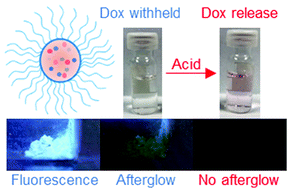Triggered and monitored drug release from bifunctional hybrid nanocomposites†
Abstract
Polymer-coated carbon dot-containing calcium carbonate nanoparticles are reported as unique nanocomposites capable of encapsulating a chemotherapeutic drug and displaying afterglow behaviour. The poly(amino acid) polymeric component enhances nanoparticle dispersion and drug retention in aqueous solution, and can be designed to be cleavable to enable doxorubicin release under acidic conditions. The encapsulated carbon nanodots offer fluorescence and brief afterglow to the nanocomposites at neutral pH, which is lost when the nanocomposites encounter acidic (pH 5) solution. The loss of drug molecules, and fluorescence and phosphorescence provided by the carbon dots, in acidic solution ensures that the reported materials have potential promise as early-stage candidates as devices for monitored payload delivery to acidic environments.



 Please wait while we load your content...
Please wait while we load your content...